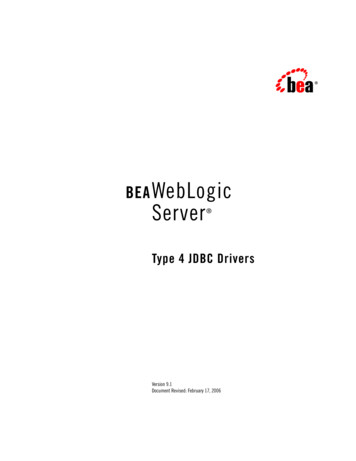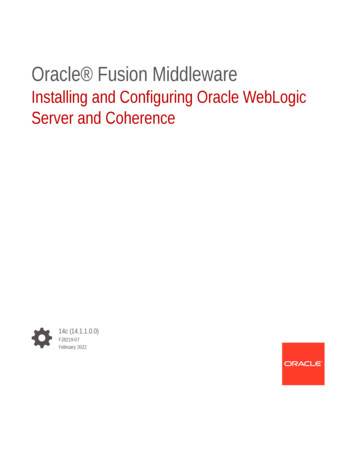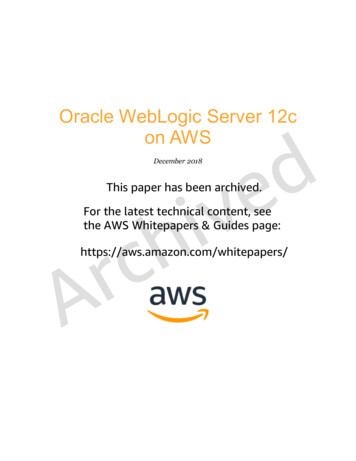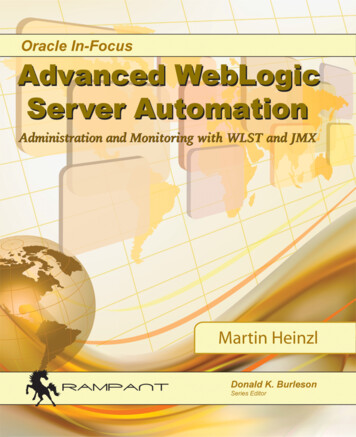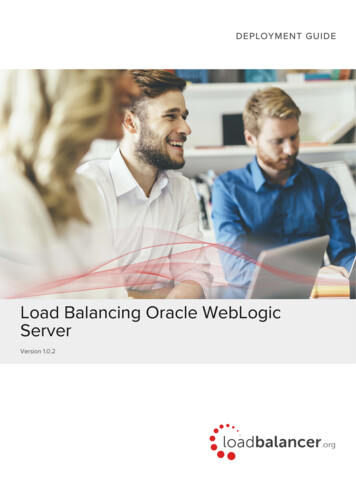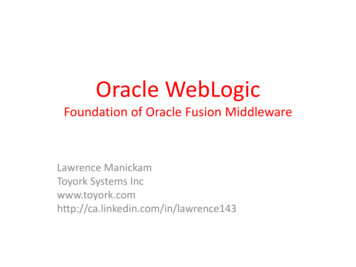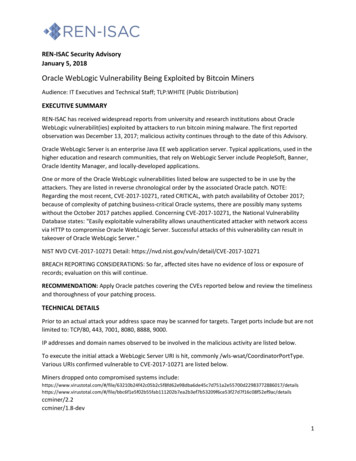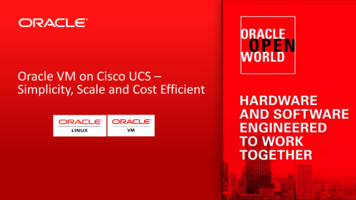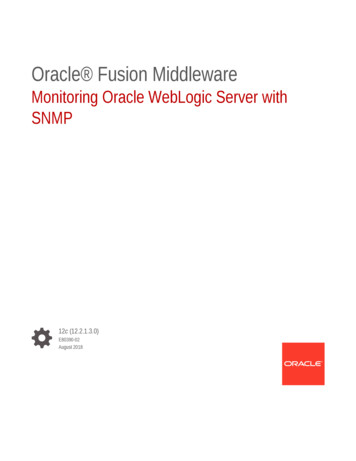
Transcription
Oracle Fusion MiddlewareMonitoring Oracle WebLogic Server withSNMP12c (12.2.1.3.0)E80390-02August 2018
Oracle Fusion Middleware Monitoring Oracle WebLogic Server with SNMP, 12c (12.2.1.3.0)E80390-02Copyright 2007, 2018, Oracle and/or its affiliates. All rights reserved.This software and related documentation are provided under a license agreement containing restrictions onuse and disclosure and are protected by intellectual property laws. Except as expressly permitted in yourlicense agreement or allowed by law, you may not use, copy, reproduce, translate, broadcast, modify,license, transmit, distribute, exhibit, perform, publish, or display any part, in any form, or by any means.Reverse engineering, disassembly, or decompilation of this software, unless required by law forinteroperability, is prohibited.The information contained herein is subject to change without notice and is not warranted to be error-free. Ifyou find any errors, please report them to us in writing.If this is software or related documentation that is delivered to the U.S. Government or anyone licensing it onbehalf of the U.S. Government, then the following notice is applicable:U.S. GOVERNMENT END USERS: Oracle programs, including any operating system, integrated software,any programs installed on the hardware, and/or documentation, delivered to U.S. Government end users are"commercial computer software" pursuant to the applicable Federal Acquisition Regulation and agencyspecific supplemental regulations. As such, use, duplication, disclosure, modification, and adaptation of theprograms, including any operating system, integrated software, any programs installed on the hardware,and/or documentation, shall be subject to license terms and license restrictions applicable to the programs.No other rights are granted to the U.S. Government.This software or hardware is developed for general use in a variety of information management applications.It is not developed or intended for use in any inherently dangerous applications, including applications thatmay create a risk of personal injury. If you use this software or hardware in dangerous applications, then youshall be responsible to take all appropriate fail-safe, backup, redundancy, and other measures to ensure itssafe use. Oracle Corporation and its affiliates disclaim any liability for any damages caused by use of thissoftware or hardware in dangerous applications.Oracle and Java are registered trademarks of Oracle and/or its affiliates. Other names may be trademarks oftheir respective owners.Intel and Intel Xeon are trademarks or registered trademarks of Intel Corporation. All SPARC trademarks areused under license and are trademarks or registered trademarks of SPARC International, Inc. AMD, Opteron,the AMD logo, and the AMD Opteron logo are trademarks or registered trademarks of Advanced MicroDevices. UNIX is a registered trademark of The Open Group.This software or hardware and documentation may provide access to or information about content, products,and services from third parties. Oracle Corporation and its affiliates are not responsible for and expresslydisclaim all warranties of any kind with respect to third-party content, products, and services unless otherwiseset forth in an applicable agreement between you and Oracle. Oracle Corporation and its affiliates will not beresponsible for any loss, costs, or damages incurred due to your access to or use of third-party content,products, or services, except as set forth in an applicable agreement between you and Oracle.
ContentsPreface12Documentation AccessibilityvConventionsvIntroduction and Roadmap1.1Document Scope and Audience1-11.2Guide to this Document1-11.3Related Documentation1-21.4Standards Supported by WebLogic Server SNMP1-21.5New and Changed Features in This Release1-2Understanding the WebLogic Server SNMP Agents and MIB2.1Overview of SNMP2-12.2WebLogic Server SNMP Agents2-12.2.1Organizing SNMP Agents in a Domain2.2.1.12.32.42-2Domain-Scoped Agent2-32.2.2Configuring SNMP Protocols2-42.2.3Configuring UDP and TCP Ports2-42.2.4Narrowing the Scope of a Request2-42.2.5Monitoring SNMP Agents2-5Security for SNMP2-52.3.1Community Names for SNMPv1 and SNMPv22-52.3.2Disabling SNMPv1 and SNMPv22-52.3.3Configuring Security for SNMPv32-62.3.4Invalidating the SNMPv3 Credential Cache2-6MIB Module for WebLogic Server2.4.1Hierarchical Data Model2-62-72.4.1.1Configuration and Runtime Hierarchies2-82.4.1.2Relationship of the MIB Module to the WebLogic Server MBeanData Model2-82.4.2Object Identifiers2-8iii
2.4.2.12.4.32.52-92-92-93.1INFORM Notifications and TRAP Notifications3-13.2Automatically Generated Notifications3-13.3Log Message Notifications3-23.43.5Variable Bindings in Monitor NotificationsAttribute Change Notifications3.5.13.6Variable Bindings in Log Message NotificationsMonitor Notifications3.4.1Variable Bindings in Attribute Change NotificationsOIDs for WebLogic Server Notifications3-33-33-53-53-63-6Understanding SNMP Proxies4.14.25Structure of the Custom MBean MIB Module2-9Understanding WebLogic Server Notifications3.3.14Browsing the MIBMonitoring Custom MBeans2.5.13OIDs for Objects and VariablesSNMP Agent as Proxy for Other Agents4-14.1.1Configuring the SNMP Protocols for Proxied Communication4-14.1.2Specifying Credentials for Proxied Communication4-24.1.3Choosing Listen Ports for Proxied Agents4-2The Microsoft Windows SNMP Service4-3WebLogic SNMP Command-Line Utility5.1Required Environment for the SNMP Command Line Utility5-15.2Syntax and Commands for the SNMP Command-Line Utility5-15.3Examples5-3iv
PrefaceThis preface describes the document accessibility features and conventions used inthis guide—Monitoring Oracle WebLogic Server with SNMP.Documentation AccessibilityFor information about Oracle's commitment to accessibility, visit the OracleAccessibility Program website at http://www.oracle.com/pls/topic/lookup?ctx acc&id docacc.Access to Oracle SupportOracle customers that have purchased support have access to electronic supportthrough My Oracle Support. For information, visit http://www.oracle.com/pls/topic/lookup?ctx acc&id info or visit http://www.oracle.com/pls/topic/lookup?ctx acc&id trsif you are hearing impaired.ConventionsThe following text conventions are used in this document:ConventionMeaningboldfaceBoldface type indicates graphical user interface elements associatedwith an action, or terms defined in text or the glossary.italicItalic type indicates book titles, emphasis, or placeholder variables forwhich you supply particular values.monospaceMonospace type indicates commands within a paragraph, URLs, codein examples, text that appears on the screen, or text that you enter.v
1Introduction and RoadmapThis chapter describes the content and organization of this guide—Monitoring OracleWebLogic Server with SNMP. This document explains the capabilities of the SimpleNetwork Management Protocol (SNMP) in WebLogic Server, and how SNMP can beused in WebLogic Server to enable enterprise-wide management systems to manageheterogeneous software and hardware environments from a single managementconsole.This chapter includes the following sections: Document Scope and Audience Guide to this Document Related Documentation Standards Supported by WebLogic Server SNMP New and Changed Features in This Release1.1 Document Scope and AudienceThis document is a resource for systems administrators who use SNMP to monitorWebLogic Server.The topics in this document describe the SNMP capabilities of WebLogic Server. TheWebLogic Server Administration Console Online Help provides specific, task-relatedinformation on configuring SNMP services in a WebLogic Server domain.It is assumed that the reader is familiar with SNMP and general network managementconcepts. For background information on SNMP, refer to the documents listed inRelated Documentation.1.2 Guide to this DocumentThis document is organized as follows: This chapter describes the audience of the guide and provides pointers to relateddocumentation. Understanding the WebLogic Server SNMP Agents and MIB, describes basicconcepts of Simple Network Management Protocol as they apply to managingWebLogic Servers. Understanding WebLogic Server Notifications, describes the characteristics ofWebLogic enterprise-specific SNMP notifications. Understanding SNMP Proxies, describes how WebLogic Server can function as amaster agent that proxies for other SNMP agents. WebLogic SNMP Command-Line Utility, describes a command-line utility thatoffers many of the same features as an SNMP manager.1-1
Chapter 1Related Documentation1.3 Related DocumentationFor step-by-step instructions on configuring SNMP services in a WebLogic Serverdomain, see Use SNMP to monitor WebLogic Server in the Oracle WebLogic ServerAdministration Console Online Help.For information on other technologies for monitoring WebLogic Server, see thefollowing documents: Developing Custom Management Utilities Using JMX for Oracle WebLogic Server Configuring and Using the Diagnostics Framework for Oracle WebLogic ServerFor background information on SNMP, see com.protocols.snmp SNMP FAQ Part 1(http://www.faqs.org/faqs/snmp-faq/part1/) and Part 2 (http://www.faqs.org/faqs/snmp-faq/part2/).1.4 Standards Supported by WebLogic Server SNMPThis release of WebLogic Server supports the following SNMP standards:Table 1-1Supported SNMP StandardsFeaturesSupported StandardsSNMP protocolSNMPv1, SNMPv2, SNMPv3Network protocolUDP, TCPAuthentication protocol HMAC-MD5-96, HMAC-SHA-96for SNMPv3Privacy protocol forSNMPv3 Cipher block chaining or CBC mode of the Data EncryptionStandardThe Advanced Encryption Standard (AES) Cipher Algorithm.SeeRFC 3826 at http://www.rfc-archive.org/getrfc.php?rfc 38261.5 New and Changed Features in This ReleaseFor a comprehensive listing of the new WebLogic Server features introduced in thisrelease, see What's New in Oracle WebLogic Server.1-2
2Understanding the WebLogic ServerSNMP Agents and MIBThis chapter describes the Simple Network Management Protocol (SNMP)management model and how WebLogic Server implements this model. You can useSNMP to provide monitoring data to enterprise-wide management systems.This chapter includes the following sections: Overview of SNMP WebLogic Server SNMP Agents Security for SNMP MIB Module for WebLogic Server Monitoring Custom MBeansSee also: Use SNMP to monitor WebLogic Server in the Oracle WebLogic ServerAdministration Console Online Help.2.1 Overview of SNMPWith SNMP, a manager sends a request for information about managed resources toan agent. The agent gathers the requested data and returns a response. You can alsoconfigure agents to issue unsolicited reports (notifications) to managers when theydetect predefined thresholds or conditions on a managed resource.To request data about a specific managed resource, a manager must be able touniquely identify the resource. In SNMP, each type of managed resource is describedin a Management Information Base (MIB) as a managed object with a unique objectidentifier (OID). Individual organizations define their specific managed objects in MIBmodules. Both manager and agent must have access to the same MIB module tocommunicate about specific managed resources.2.2 WebLogic Server SNMP AgentsWebLogic Server SNMP agents query the WebLogic Server management system andcommunicate the results to managers over the SNMP protocol. The WebLogic Servermanagement system exposes management data through a collection of managedbeans (MBeans). When a WebLogic Server SNMP agent receives a request from amanager, it determines which MBean corresponds to the OID in the manager'srequest. Then it retrieves the data and wraps it in an SNMP response.You can use WebLogic Server SNMP agents to: Respond to simple GET requests from an SNMP manager for the current value ofWebLogic Server MBean attributes.2-1
Chapter 2WebLogic Server SNMP AgentsNote:WebLogic Server does not enable SNMP managers to set the values ofMBeans or invoke MBean operations. SNMP managers can be usedonly to monitor WebLogic Server. Use JMX monitors to poll WebLogic Server MBeans periodically and sendnotifications to SNMP managers when the MBean attributes change in a way thatyou specify. Send notifications to SNMP managers when the Administration Server or anyManaged Server starts or shuts down. Listen for specific log messages and send notifications to SNMP managers whenWebLogic Server generates them. Act as a proxy agent that passes requests from an SNMP manager to other (nonWebLogic) SNMP agents (such as an Oracle database agent) on the samemachine.2.2.1 Organizing SNMP Agents in a DomainIn each WebLogic Server domain, you can create multiple SNMP agents and organizethem into a de-centralized or centralized model for SNMP monitoring andcommunication: In a de-centralized model, you create SNMP agents on each Managed Server.SNMP managers communicate with the agents on individual Managed Servers.See Figure 2-1. In a centralized model, you create an SNMP agent only on the AdministrationServer. SNMP managers communicate only with the SNMP agent on theAdministration Server and the agent gathers monitoring data from all ManagedServers in the domain. See Figure 2-2.This model is convenient and enables a single request to retrieve data for theentire domain, but:–If the Administration Server is unavailable, you cannot monitor the domainthrough SNMP.–If the domain is large, you must filter a large amount of data to find informationabout a specific resource. Instead of filtering data in the response, you cannarrow the scope of the request. See Narrowing the Scope of a Request.–The model introduces performance overhead. To gather data from all serversin a domain, the agent on the Administration Server queries MBeans in theDomain Runtime MBean server. This MBean server contains MBeans fordomain-wide services and acts as a single point of access for MBeans thatreside on Managed Servers. Because the Domain Runtime MBean servercommunicates with all Managed Servers in the domain, it is subject to networklatency and increases the amount of memory that the Administration Serveruses.Figure 2-1 illustrates that when you create SNMP agents on individual servers in adomain, the agents query MBeans in the host server's Runtime MBean server. ThisMBean server contains only the MBeans for the individual host server.2-2
Chapter 2WebLogic Server SNMP AgentsFigure 2-1De-Centralized Model for SNMP Monitoring and CommunicationFigure 2-2 illustrates that when you use the SNMP agent on the Administration Serverto retrieve data for Managed Servers, the agent queries MBeans in the DomainRuntime MBean server.Figure 2-2Centralized Model for SNMP Monitoring and CommunicationFor information on creating WebLogic Server SNMP agents, see Create SNMP agentsin the Oracle WebLogic Server Administration Console Online Help.2.2.1.1 Domain-Scoped AgentTo support domains that were created with WebLogic Server release 9.2 and earlier,you can enable and use the domain-scoped SNMP agent instead of configuring SNMP2-3
Chapter 2WebLogic Server SNMP Agentsagents on the Administration Server or Managed Servers (server SNMP agents). Thedomain-scoped agent offers the same features as the server SNMP agent in thecentralized model described above. However, its underlying implementation is differentand it will eventually be deprecated. The domain-scoped agent is overridden if youtarget a server SNMP agent to the Administration Server.2.2.2 Configuring SNMP ProtocolsA WebLogic Server SNMP agent can always communicate with managers using theSNMPv3 protocol. You can configure whether the agent also supports the SNMPv1and SNMPv2 protocols. While you cannot prevent an agent from receiving SNMPv3requests, an agent processes only requests from known users that you configurethrough the WebLogic Server security realm.See Create SNMP agents in the Oracle WebLogic Server Administration ConsoleOnline Help.2.2.3 Configuring UDP and TCP PortsAn SNMP agent communicates through a port that accepts UDP traffic and anotherport that accepts TCP traffic. By default, all TCP traffic uses the host server's listenport. For example, if you target this agent to a server named ManagedServer1 andManagedServer1 listens for requests on port 7001, then the SNMP agent listens forTCP requests on port 7001. When communicating through a TCP port, WebLogicServer protects SNMP communication from denial of service (DOS) attacks.If you want to separate SNMP TCP traffic from business traffic, you can create acustom network channel.See Create SNMP agents and Create an SNMP network channel in the OracleWebLogic Server Administration Console Online Help.2.2.4 Narrowing the Scope of a RequestWhen an SNMP manager sends a request to an agent on the Administration Server,the agent's response can potentially contain data that describes multiple instances ofthe object. For example, the object serverUptime exists for each WebLogic Serverinstance in a domain. If a manager sends a request for serverUptime to an agent on anAdministration Server, the response contains one serverUptime instance for eachserver in the domain.You can narrow the scope of a request by encoding additional information in themanager's request. The information that you encode depends on which SNMPprotocol you use: In a request that uses the SNMPv1 or SNMPv2 protocol, append the name of theserver instance to the SNMP community name that it sends with the request asfollows:community prefix@server namewhere community prefix is the SNMP community name and server name is thename of the targeted Managed Server. The community prefix value sent by themanager must match the value that you set in the Community Prefix field whenyou configure the SNMP agent.2-4
Chapter 2Security for SNMPTo request a managed object for all server instances in a domain, send acommunity name to the WebLogic SNMP agent with the following form:community prefix In a request that uses the SNMPv3 protocol, encode the name of the ManagedServer in the request's context name field.2.2.5 Monitoring SNMP AgentsFor each SNMP agent in a domain, the SNMP: Monitoring tab of the WebLogic ServerAdministration Console provides such information as how many notifications the agenthas sent to managers and how many authentication attempts have failed. See MonitorSNMP agents in Oracle WebLogic Server Administration Console Online Help.You can also access this monitoring information using WebLogic Scripting Tool(WLST) or a JMX client to access the new SNMPAgentRuntimeMBean. SeeSNMPAgentRuntimeMBean in MBean Reference for Oracle WebLogic Server. Forinformation about using WLST, see Understanding the WebLogic Scripting Tool.2.3 Security for SNMPThe security features that are available for SNMP depend on which SNMP protocol anagent uses to communicate with managers.Oracle strongly recommends using the SNMPv3 protocol instead of SNMPv1 andSNMPv2.2.3.1 Community Names for SNMPv1 and SNMPv2To ensure that an SNMP manager requesting data from the WebLogic SNMP agenthas permission to obtain the data, and to verify that the agent has permission to sendnotifications to a target manager, SNMPv1 and SNMPv2 use clear-text passwordscalled community names.When you create an SNMP agent (described in Create SNMP agents in the OracleWebLogic Server Administration Console Online Help), you specify the communityname that the agent expects from the SNMP manager.2.3.2 Disabling SNMPv1 and SNMPv2By default, Simple Network Management Protocol (SNMP) is disabled in WebLogicServer. However, after you enable SNMP, the SNMPv1 and SNMPv2 protocols areenabled. Because SNMPv1 and SNMPv2 use clear text passwords, they are notsecure and can cause certain potential security problems to occur on the SNMPservice, including unauthorized access and Denial of Service attacks. Oracle stronglyrecommends disabling the SNMPv1 and SNMPv2 protocols and using the SNMPv3protocol instead. You can disable SNMPv1 and SNMPv2 by disabling communitybased access for each SNMP agent. See Create SNMP agents in the OracleWebLogic Server Administration Console Online Help.If you cannot use SNMPv3, you must limit the weak security problems in SNMP v1and SNMPv2 by ensuring that your network is secure and that the firewall isconfigured to restrict access to the ports in your WebLogic Server environment.2-5
Chapter 2MIB Module for WebLogic Server2.3.3 Configuring Security for SNMPv3Oracle strongly recommends using the SNMPv3 protocol instead of SNMPv1 andSNMPv2.In the SNMPv3 protocol, both SNMP agent and manager must encode identicalcredentials in their PDUs for the communication to succeed. The credentials includeseveral tokens: a user name, an SNMP engine ID, an authorization protocol, and anoptional privacy password, all of which are encrypted before being transported overthe network.In WebLogic Server, SNMP agents work with the domain's security realm to securecommunication. The SNMP agent decodes SNMP credentials in requests and passesthe SNMP user name to the security realm. The security realm maps the SNMP username to a WebLogic Server user, authenticates the user, and authorizes access tomonitoring data in the domain. To map the SNMP credentials to a user in a WebLogicServer security realm, you create a credential map.For information about how to configure security for SNMPv3, see Secure SNMPv3communication in the Oracle WebLogic Server Administration Console Online Help.2.3.4 Invalidating the SNMPv3 Credential CacheTo optimize performance, an SNMP agent caches the credential maps that correlateWebLogic Server users with SNMP credentials. To make sure that the cache containsthe latest set of SNMP credentials, an agent periodically invalidates its cache. After thecache is invalidated, the next time the agent requests credentials, it regenerates itscache.Note that making a change to the credential map does not automatically update thecache for SNMP agents. Instead, the cache is updated only after it has beeninvalidated. For example, if you update a privacy password in an existing entry in theSNMP credential map, SNMP agents are not aware of the new password until theircaches are invalidated and regenerated. An SNMP user with the old security passwordcan still use the agents to access WebLogic Server data until the cache is invalidated.After you modify a credential map, you can either wait for each SNMP agent toinvalidate its cache, or you can invalidate it immediately.For information on invalidating the cache immediately, see Invalidate an SNMPcredentials cache in the Oracle WebLogic Server Administration Console Online Help.You can configure the frequency with which an agent invalidates its cache when youcreate the agent. See Create SNMP agents in the Oracle WebLogic ServerAdministration Console Online Help.2.4 MIB Module for WebLogic ServerThe MIB module for WebLogic Server uses Abstract Syntax Notation.1 (ASN.1) todescribe the resource types that can be monitored through SNMP and the notificationtypes that WebLogic Server SNMP agents can send to SNMP managers.The WebLogic Server installer creates a copy of the MIB module in the followinglocation, where WL HOME represents the root installation directory WebLogic Server:2-6
Chapter 2MIB Module for WebLogic ServerWL HOME/server/lib/BEA-WEBLOGIC-MIB.asn1With each new release, WebLogic Server appends any new managed objects to themodule. The object identifiers for existing managed objects do not change from onerelease to the next.The following sections describe the WebLogic Server MIB module: Hierarchical Data Model Object Identifiers Browsing the MIB2.4.1 Hierarchical Data ModelWebLogic Server exposes a large number of data points in its management system.To organize this data, it provides a hierarchical data model that reflects the collectionof services and resources that are available in a domain. For example, a WebLogicServer domain can contain multiple servers. Each server contains (or hosts)applications, and each application contains Web applications, EJBs, and other JavaEE modules.The WebLogic Server MIB module reflects this hierarchy. For example, a WebLogicServer domain describes its overall configuration in a tabular managed object calleddomainTable. This tabular object refers to (contains) a collection of scalar objects, eachof which describes some attribute of the domain. For example, domainTable contains adomainServers scalar object that names all servers in the domain. The serverTableobject contains a serverDeployments scalar object, which describes all applicationscurrently deployed on a server.Tabular objects never directly contain object instances (MIB variables). Instead,tabular objects contain scalar objects, and the scalar objects contain variables. Forexample, if you created two Managed Servers in a domain named MS1 and MS2, theMIB contains one serverTable object, which in turn contains a serverName object. TheserverName object contains two variables that contain the value MS1 and MS2. SeeFigure 2-3.Figure 2-3Hierarchy of Objects and Object Instances2-7
Chapter 2MIB Module for WebLogic Server2.4.1.1 Configuration and Runtime HierarchiesInstead of one large hierarchy for all of its management data, the WebLogic Servermanagement data model consists of two hierarchies: one for its configuration data andanother for the performance and monitoring data that are available only at runtime. Allmanaged objects that describe runtime data contain the word "runtime" in their name;configuration managed objects do not. For example, the MIB contains a domainTablethat describes a domain's configuration and a domainRuntimeTable that describesruntime data.2.4.1.2 Relationship of the MIB Module to the WebLogic Server MBean DataModelWebLogic Server provides managed beans (MBeans) as part of its implementation ofJava Management Extensions (JMX). JMX is a Java EE specification for programmaticaccess to a Web application server's management data, and an MBean is therepresentation of the management data and operations. JMX's purpose is the same asSNMP: provide standard communication of management information between agentsand managers.At the implementation level, the WebLogic Server SNMP agent and MIB form aprotocol-specific layer on top of the WebLogic Server JMX implementation. If you arealready familiar with the WebLogic Server JMX implementation, you will noticesimilarities in the data model for WebLogic Server MBeans and the organization ofmanaged objects in the WebLogic Server MIB. However, there are some importantdifferences: WebLogic Server enables JMX clients (similar to SNMP managers) to monitor adomain and to modify a domain configuration. WebLogic Server gives SNMPmanagers only read access to its management system. The data model for MBeans is a deep hierarchy, while the data model implied bythe MIB is shallow. For example, a JMX client can navigate from a DomainMBean toits child ServerMBeans, and then to the children of each ServerMBean, and so on. TheMIB, on the other hand, represents objects using unique identifiers. See ObjectIdentifiers. Entries for MBean attributes that are either complex types or arrays of complextypes are not included in the SNMP MIB. Only MBean attributes that are eitherString or simple types, or arrays of String or simple types, are defined in the MIB.For more information about the WebLogic Server JMX implementation, seeDeveloping Manageable Applications Using JMX for Oracle WebLogic Server.2.4.2 Object IdentifiersA MIB assigns a unique, immutable number called an object identifier (OID) to eachmanaged object that it describes. Each OID consists of a left-to-right sequence ofintegers. This sequence defines the location of the object in the MIB tree and specifiesa unique path through the tree to the object. Each node in the path has both a numberand a name associated with it.The path .1.3.6.1.4.1 defines the private.enterprises OID and each number beneaththat node on the tree represents the branches in the tree reserved for a particularvendor, for example, Oracle. The MIB modules are registered at the location .2-8
Chapter 2Monitoring Custom MBeans1.3.6.1.4.1.140 in the tree, and the WebLogic Server MIB module consists of all OIDsbelow .1.3.6.1.4.1.140.625.2.4.2.1 OIDs for Objects and VariablesThe WebLogic Server MIB module uses OIDs to reflect its hierarchical data model. Forexample, the OID for the serverRuntimeTable object is .1.3.6.1.4.1.140.625.360. TheOID for the serverRuntimeState scalar object, which is contained by theserverRuntimeTable object is .1.3.6.1.4.1.140.625.360.1.60.To identify an object instance (variable), the WebLogic SNMP agent generates andappends an additional set of numbers to the object's OID. For example, the OID for avariable of serverRuntimeState would 0.100.102.53.55.97.101.52.56.99.99.97.99.The OID is persistent across instantiations of the object.You can view the contents of BEA-WEBLOGIC-MIB.asn1 to see the OIDs for managedobjects, and the SnmpWalk or SnmpGetNext commands to see the OIDs for any variable.See WebLogic SNMP Command-Line Utility.2.4.3 Browsing the MIBTo view the contents of the MIB module for WebLogic Server, Oracle recommendsusing a MIB browser. WebLogic Server does not provide a MIB browser, but mostvendors of SNMP utilities do.The MIB module is contained in the following location in your WebLogic Serverinstallation directory:WL HOME/server/lib/BEA-WEBLOGIC-MIB.asn12.5 Monitoring Custom MBeansYou can configure a WebLogic SNMP agent to maintain a runtime MIB module thatcontains entries for all custom MBeans that have been registered in a WebLogicServer Runtime MBean Server. A custom MBean is an MBean that you create andregister (see Developing Manageable Applications Using JMX for Oracle WebLogicServer). You can then use SNMP managers to request information about your customMBea
See also: Use SNMP to monitor WebLogic Server in the Oracle WebLogic Server Administration Console Online Help. 2.1 Overview of SNMP With SNMP, a manager sends a request for information about managed resources to an agent. The agent gathers the requested data and returns a response. You can also
